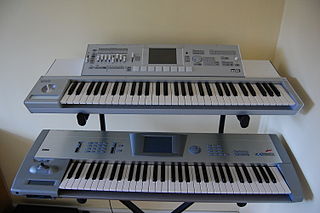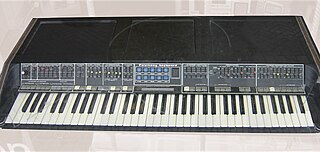
GarageBand is a line of digital audio workstations developed by Apple for macOS, iPadOS, and iOS devices that allows users to create music or podcasts. GarageBand was originally released for macOS in 2004 and brought to iOS in 2011. The app’s music and podcast creation system enables users to create multiple tracks with pre-made MIDI keyboards, pre-made loops, an array of various instrumental effects, and voice recordings.

The Yamaha DX7 is a synthesizer manufactured by the Yamaha Corporation from 1983 to 1989. It was the first successful digital synthesizer and is one of the best-selling synthesizers in history, selling more than 200,000 units.

The Roland D-50 is a synthesizer produced by Roland and released in April 1987. Its features include subtractive synthesis, on-board effects, a joystick for data manipulation, and an analogue synthesis-styled layout design. The external Roland PG-1000 (1987–1990) programmer could also be attached to the D-50 for more complex manipulation of its sounds. It was also produced in a rack-mount variant design, the D-550 (1987–1990), with almost 450 user-adjustable parameters.

Novation Digital Music Systems Ltd. is a British musical equipment manufacturer, founded in 1992 by Ian Jannaway and Mark Thompson as Novation Electronic Music Systems. Today the company specializes in MIDI controllers with and without keyboards, both analog and virtual analog performance synthesizers, grid-based performance controllers, and audio interfaces. At present, Novation products are primarily manufactured in China.

The Korg Triton is a music workstation synthesizer, featuring digital sampling and sequencing, released in 1999. It uses Korg's HI Synthesis tone generator and was eventually available in several model variants with numerous upgrade options. The Triton became renowned as a benchmark of keyboard technology, and has been widely featured in music videos and live concerts. At the NAMM 2007, Korg announced the Korg M3 as its successor.

Logic Pro is a proprietary digital audio workstation (DAW) and MIDI sequencer software application for the macOS platform developed by Apple Inc. It was originally created in the early 1990s as Notator Logic, or Logic, by German software developer C-Lab which later went by Emagic. Apple acquired Emagic in 2002 and renamed Logic to Logic Pro. It is the second most popular DAW – after Ableton Live – according to a survey conducted in 2015.
Electribe is a group of electronic musical instruments by Korg. From its beginnings with the Electribe R to the ESX-1, this series includes both analogue modeling synthesizers and sampling drum machines that can be programmed the same as a drum machine. The analogue modeling synth and sampling drum machine both share a drum-pattern section and a synth-pattern section, whereby the user can not only program drum patterns, but also synth and basslines. These hybrid machines could be considered 'grooveboxes'.

The Moog synthesizer is a modular synthesizer developed by the American engineer Robert Moog. Moog debuted it in 1964, and Moog's company R. A. Moog Co. produced numerous models from 1965 to 1981, and again from 2014. It was the first commercial synthesizer and established the analog synthesizer concept.
Arturia is a French electronics company founded in 1999 and based in Grenoble, France. The company designs and manufactures audio interfaces and electronic musical instruments, including software synthesizers, drum machines, analog synthesizers, digital synthesizers, MIDI controllers, sequencers, and mobile apps.
Sascha Dikiciyan, known professionally as Sonic Mayhem, is a German game musician, producer and professional sound designer of Armenian origin, who has produced the soundtrack for Quake II, Tomorrow Never Dies and Hellgate: London, as well as approximately half of the soundtrack for Quake III Arena and all the weapon sound effects for Unreal Tournament and, since the build 222 patch, also its predecessor, Unreal. Dikiciyan has also produced independent music albums.

The Polymoog is a hybrid polyphonic analog synthesizer that was manufactured by Moog Music from 1975 to 1980. The Polymoog was based on divide-down oscillator technology similar to electronic organs and string synthesizers of the time.
Drew Neumann is an American musician and composer of film and television scores. He created the soundtrack of the science fiction animated series Æon Flux, and has composed music for many other shows, including The Wild Thornberrys, Bunnicula, The Grim Adventures of Billy & Mandy and Aaahh!!! Real Monsters. He studied film, animation, and composition at the California Institute of the Arts, where he graduated with a BFA (1982). He has been longtime friends with animator Peter Chung. He also assisted in the development of, and contributed sound patches and timbres to Moog Music's award-winning Animoog iPad app.

The SH-3A is a monophonic analog synthesizer that was manufactured by Roland from 1975 to 1981. It is unique in that it is capable of both the usual subtractive synthesis and also the less common additive synthesis, offering mixable waveforms at different footages. Two LFOs and a unique sample-and-hold section provided capabilities not found in competing self-contained synthesizers of the time. The SH-3A was Roland's first non-preset based synth. The predecessor, the Roland SH-1000, could also do this but didn't offer as much control as on the SH-3A. The rhythmic pulsing in the Blondie song "Heart of Glass" is an example of its sound.

A synthesizer is an electronic musical instrument that generates audio signals. Synthesizers typically create sounds by generating waveforms through methods including subtractive synthesis, additive synthesis and frequency modulation synthesis. These sounds may be altered by components such as filters, which cut or boost frequencies; envelopes, which control articulation, or how notes begin and end; and low-frequency oscillators, which modulate parameters such as pitch, volume, or filter characteristics affecting timbre. Synthesizers are typically played with keyboards or controlled by sequencers, software or other instruments and may be synchronized to other equipment via MIDI.

The Roland JV-1080 is a sample-based synthesizer/sound module in the form of a 2U rack. The JV-1080's synthesizer engine was also used in Roland's XP-50 workstation (1995). Due to its library of high-quality sounds and multi-timbral capabilities, it became a mainstay with film composers.

Auxy: Beat Studio, commonly referred to as Auxy, is a sequencer app for creating electronic music loops and capable of creating full-length tracks, made for the Apple iPad by a 3-person development team and released for free on the iOS App Store on October 29, 2014.

Syntorial is a synthesizer-teaching software created by Audible Genius, a company owned by website programmer, musician and teacher Joe Hanley. He was inspired to make the program by his frustration of learning synthesis in his early career, and wanted to create something that would train the user to design a patch by ear. Kickstarter-funded in 2012, the program was officially released for Microsoft Windows and OS X on August 27, 2013, and for the iPad on June 25, 2015. The synth that is built into the software is called Primer, which was released as a VST and AU in November 2013. Syntorial garnered critical acclaim with reviewers praising it a fun way to learn synthesis, earning an Editors’ Choice Award from Electronic Musician in 2014. The latest version of Syntorial is 2.0, which was released in July, 2023.
Maschine is a hardware/software digital audio workstation developed by Native Instruments. Maschine consists of a controller that connects to the included sequencing software, which can be installed on any compatible computer or laptop.
The Model 15 is a music synth and an educational tool mobile app designed for iPad, iPhone and iPod Touch. It is a software recreation of a Model 15 modular synth from 1973.










